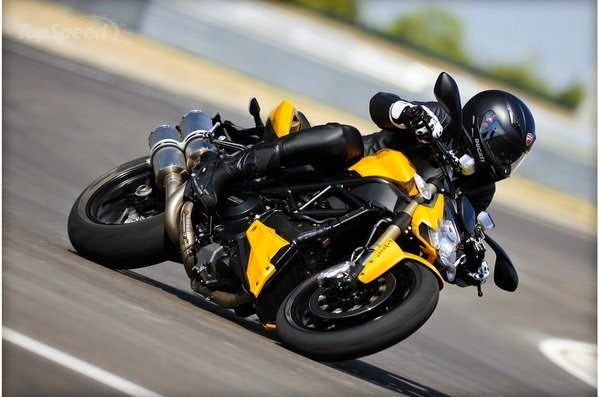SPECIFICATIONS:
year: 2012
make: Ducati
Model: Streetfigher
price: $ 12995
Engine: L-Twin cylinder, 4 valve per cylinder Desmodromic, liquid cooled
Horsepower @ RPM: 132 @ 10000
MPG(Cty): 23
MPG(Hwy): 29
Torque @ RPM: 69 @ 9500
Displacement: 849 cc
Top Speed: 124 mph
Ducati has unleashed its Streetfighter 848 in 2012 and despite the fact that is slightly weaker than its bigger brothers; the bike has still a lot to love. It features a capable L-Twin unit, savvy chassis technology, a single-sided swingarm and monobloc brakes.
The motorcycle sits on lightweight, 10-spoke aluminum wheels, 5.5-inches wide out back, 3.5-inches wide up front. The wheels are shod in Pirelli Diablo Rossi Corsa tires designed from World Superbike Championship technology - 120/70/ZR17 front and 180/60/ZR17 back.
One of the most modern technologies offered by the 2012 Ducati Streetfighter 848 is the Ducati Traction Control (DTC) which offers eight profiles, each one programmed with a wheel-spin tolerance matched to progressive riding levels of skill, graded from one to eight.
The rider is met by a modern digital unit in the instrument cluster which displays information for Speedometer, rev counter, lap times, time, air temp, coolant temp, battery voltage, A & B trips, fuel reserve trip, DTC status and level selected (if activated) scheduled maintenance.
Press Release
The new Streetfighter 848 offers pure motorcycling thrills thanks to its perfect combination of 848 Testastretta 11° engine and a new Trellis frame with Superbike 848EVO-derived geometry. Outstanding control and precision make the Streetfighter 848 irresistible. Thanks to the superb handling offered by the new frame, the progressive easy-to-manage power delivery provided by the Testastretta 11° engine, the confidence-inspiring upright riding position and Ducati Traction Control, which keeps watch over the power, this latest interpretation of the fighter concept delivers instant, knock-out riding enjoyment.
Concept
Streetfighter Design
The Ducati Streetfighter is equipped with everything that made the Superbike a legend: Awesome L-Twin muscle with brutal, big-bore torque, thoroughbred chassis technology, beautiful single-sided swingarm, planet-stopping Monobloc brakes and pure, sophisticated class.
While the tank and seat shapes leave no doubt as to the Streetfighter’s roots, it is the upright and commanding riding position that really starts to shape the character of this ultimate naked. New, minimalistic controls, instrumentation and headlight design leave the front looking clean and mean, while twin-stacked right-side mufflers at the rear leave the tail-end high and sharp. No other Ducati has ever achieved such an aggressive stance while providing a comfortable, empowering, controllable and enjoyable ride.
Streetfighter Culture
The Streetfighter culture was born on the backstreets of Northern Europe during the late 70s and 80s. If the Café racer movement had taken traditional bikes and transformed them to establish out-and-out sportbikes, then Streetfighters were definitely anti-establishment. They evolved by removing the fairings from sport bikes, fitting higher bars and customising to create high-performance, over-the-top nakeds.
Ducati’s Streetfighter project was inevitable. The passion to build the most successful Superbikes ever, mixed with the desire to create iconic, naked motorcycles was a rush of adrenaline just waiting to happen. Who else would create a bike for out-and-out purists to celebrate naked power in all its forms? A bike with muscle-engine performance, aggressive chassis engineering and intelligent electronics all laid bare to appreciate, respect and enjoy?


